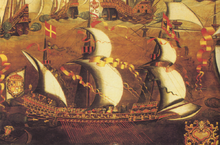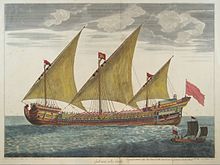|
Galleass  Look up galleass in Wiktionary, the free dictionary. A galleass was a warship that combined the sails and armament of a galleon with the maneuverability of the oared galley.[1] While never quite matching up to the full expectations for its design, the galleass nevertheless remained in use during the 16th and 17th centuries.[2] DevelopmentGalleasses were higher, larger and slower than regular galleys. They had up to 32 oars, each worked by up to five men. They usually had three masts, and unlike galleys, proper forecastles and an aftcastles. Much effort was made in Venice to make galleasses as fast as possible to compete with regular galleys. The gun deck usually ran over the rowers' heads, but there are also pictures showing the opposite arrangement. Galleasses usually carried more sails than galleys and had far more firepower;[3] a galley caught in a galleass's broadside was in great danger, since it exposed to a large amount of gunfire. Relatively few galleasses were built—one disadvantage was that, being more reliant on sails, their position at the front of the galley line at the start of a battle could not be guaranteed. Naval actions Venetian galleasses fought at the Battle of Lepanto in 1571, their firepower helping to break the force of the first Turkish attack,[4] and eventually helping to win victory for the Holy League fleet.[5] Four great Naples galleasses were deemed sufficiently seaworthy to accompany the Spanish Armada in 1588 (e.g. La Girona, eventually wrecked off Ireland), where they formed part of the front-line of fighting ships.[6] During the Channel actions, they were repeatedly called on as a squad in any calm, to rescue Spanish stragglers or cut-off a stray English ship.[7] With 50 guns apiece, 300 soldiers and sailors, and 300 rowers, they were formidable ships; but their leader was wrecked after the Calais fire ship attack, (the Battle of Gravelines), and only two of the four made it back safely to Spain.[8] Later history and parallelsIn the Mediterranean, with its less dangerous weather and fickle winds, both galleasses and galleys continued to be in use, particularly in Venice and the Ottoman Empire, long after they became obsolete elsewhere. Later, "round ships" and galleasses were replaced by galleons and ships of the line which originated in Atlantic Europe. The first Venetian ship of the line was built in 1660. See alsoReferences
External links
|